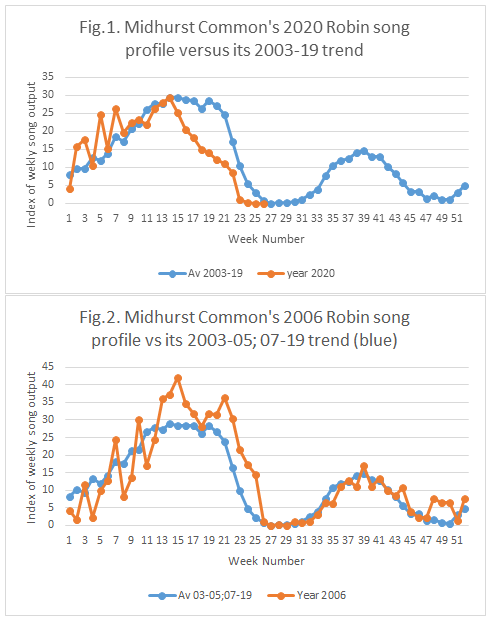
I’ve been measuring the seasonal vocal outputs of various songbirds on Midhurst Common’s woodlands in West Sussex, since 2003. This was when, on a whim, part of a regular dog walk started to include ten minutes of counting of singing individuals of each species within a series of short time frames. I do this simple, stubby pencil, amateur stuff every mid-morning (except if it’s rainy, blustery or very cold). Thus one hound’s routine ensures the tracking of some twenty familiar songs throughout the year. The point of doing such monitoring is open to debate.
In his famous book, The Life of the Robin, David Lack states that the bird’s spring song in South Devon starts suddenly in late December and continues to about the middle of June. He goes on to say that such dates are ‘rather different in other parts of England.’
So, has the Robin’s spring song now ceased where you are? If so, can you remember the week in which the last individuals stopped singing? It’s not easy is it? In fact it’s very difficult to be aware of the precise decline and ending of any familiar and repetitious activity like frequent bird song unless you monitor it regularly. One useful way to track such seasonal behaviour and capture those elusive moments of passing is to do a daily song transect. The method is easy and this woodland transect can effortlessly generate a lot of data from a potential soundscape containing, for instance, nearly two dozen Robins singing in their territories. The difficult bit is comparing any averaged results with other people’s observations.
For example, the Midhurst Robins’ 2003-19 cumulative profile (Fig.1, blue plot) suggests that their spring song might, on average, be ending nearly two weeks later than Lack’s Devon birds’ mid-June date of eighty years ago. Of course that difference is highly questionable because it is based on just two sets of unmatched observations which are separated by 150 miles. The same caution must apply to other regions, across other time spans, when comparing those different end song dates to which Lack briefly refers.

Here however, at Midhurst, safer comparisons, like year to year ones, can be made. Take the very early ending of Robin song in week 24, mid-June, this year (Fig.1, red plot) and 2006’s late cessation (Fig.2, red plot) in week 27 (centre day, 5th July). This is the largest difference so far found in eighteen years of listening. I wonder if such extremes occur in other places. I wonder if the descendants of Lack’s Robins show similar deviations for these two years.
I wonder also if the Midhurst Robins stopped breeding three weeks earlier this year compared to 2006. In other words is their spring song cessation date a reliable proxy for the timing of the last broods of the season. It would be great if that were true. Unfortunately, that type of question remains unanswerable in this study area because my nest finding abilities are totally insufficient for such a task.
So, maybe any more dogged counting is pointless. But then maybe, it’s the long chase that counts.
[registration_form]
Could the first view of a fledgling act in lieu of nest finding? Has the same lovely companion been your helper throughout?
Thanks Richard. Yes, the first view of a fledgling is a perfectly good proxy. But I rarely see very young Robins even at peak fledging times. So looking for them and sampling their frquency of occurrence throughout the breeding season (across two dozen territories) is well beyond me.
Jess, is a recently rescued dog. The original dog companion died a number of years ago.
I wonder if there is enough annual data from BTO Nest Record Scheme from southern England to help get a handle on this. So this year it might be that Robins got down to breeding earlier than usual with the good spring weather so singing tended to drop off earlier than is typical?
Thanks. Good idea, Ian. I will follow that up. But I imagine that 2020 obs. will be lacking due to lockdown. You are probably right about the good spring weather causing an earlier than usual start to breeding. However, I’m not so sure what has caused the unusually shortened song season this year.
Singing of course will die down while the nestlings are being reared. But what about the usual peak second or repeat broods. Don’t they occur in April/ early May, irrespective of an early spring? The song output should have peaked in preparation for them. But the graph suggests a steady decline from week 15 (12th April). Ok, it’s very likely to be weather related again — possibly the mini drought we had here, starting with a dry April and going through a very dry May into a dry June. (in contrast May 2006 was record breakingly wet)
And yet, if dryness does reduce the song output in Robins, it doesn’t seem to slow down other energetic songsters like the Wren.
Hi Murray
This song tracking is fascinating! I live in London but fortunately have a small, high walled garden where I have grown trees where my robin friends like to sit.
I have heard the robins’ early evening songs during the warm Spring and it’s so beautiful it makes me weep with joy!
I’m not much use to you song trackers but was drawn to your interest in these creatures who are showing me how to live a better, simpler life.
During lockdown ( I live alone) I have spent hours observing the robin family’s comings and goings. The female comes into my kitchen and sometimes hops around the flat, sometimes perching on the counter when I’m cooking.
The parents have been giving flying lessons to their babies and I realise now that I only hear the fledglings cheeping at the moment…
The whole family uses the water dish to have baths and then they sit up in the plum tree in a patch of sunlight to dry out. The female often sings a merry little tune quite quietly at this time, almost as if she is feeling all clean and happy – I know – anthropomorphising wildly 🙂
I have grown to love “my” robins. I do feed them seeds and they sometimes sit on the hose reel outside the french windows and shout at me if they’re hungry. I will start taking note of their song times now and let you know. It might be interesting to see if these hip cool Notting Hill robins have different habits to their country cousins!!
Great work Murray!
Mary
Mary – thank you for your first comment here. Robins are one of the more adventurous of our songbirds as far as penetrating the centre of London is concerned. You enjoy them!
They are very friendly and funny. They eat from my hand sometimes. I have a family of blackbirds living close by but they are more cautious although the baby once flew a bit off piste and came swooping into my kitchen. It seemed quite happy there and the parents came in to feed it until I thought I had better show it the door or start charging rent
I think I mat start to song track either Robins, Dunnocks, Wrens, or one of Blackbird or Song Thrush next year (if I remember). Lovely blog Murray and interesting, you are of course absolutely right that without daily tracking we only have a very vague idea of when birds stop singing or summer migrants leave.
I have noticed that the first brood Robins attending our bird feeders are almost indistinguishable from their parents having almost lost their spotty plumage whilst we still have later brood birds coming that have as yet no orange feathers at all. We have also had two distinct waves of juvenile Chaffinches too.
Thanks Paul. Yes, your bird feeders look to be a good way of keeping tabs on those late brood times. That’s interesting about your Chaffinches. They seem to be doing fine Wales way where you are. And I think you said back in April how well they were singing too. Here there has been yet another decreasing year of song output – in fact there is over four times less song to date this year compared to 2019. At least Greenfinches seem to have bounced back.
Mary, thank you for that. Wow, I wish I had a tenth of your patience. David Lack noted a sudden and marked increase in Robin song just after the young leave the nest. He suggests that this is the time when juvenile robins learn the song of their species although they don’t themselves sing then. He points out that young robins start to sing in late July, before the adults, so they get no other chance to learn their song.
If I had tame birds like yours I would anthropomorphise too. So I reckon that your singing parent bird can be ‘clean and happy’ and educative at the same time.
Thanks Murray.
Not just an old woman going slightly bonkers in lockdown then….
so glad to know there’s a robin loving community out there.
I planted some of the robins’ sunflower seeds last week and now have a healthy crop of young plants growing.
I like this way of life.
Of course I’m privileged in that I’m recently retired and have a garden but I don’t particularly want to “get back to normal”.
I prefer this normal.
With robins.
I’ll keep my ear tuned for changes in song. Love the idea that little robins have singing lessons as well as flying lessons. And that they keep all their vocal learning in until they’re ready to have a go. I taught nursery school and had many children pass through my care who did the same.
Have a great weekend